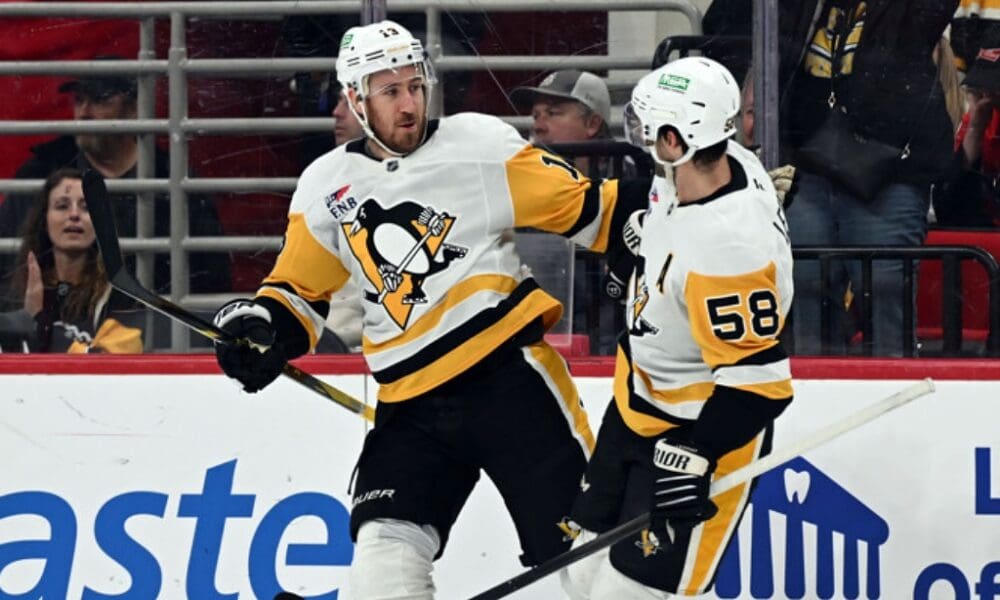When the green flag waved on July 1 on the start of NHL free agency, Pittsburgh Penguins general manager Kyle Dubas added a needed left-side defenseman, Parker Wortherspoon. However, Dubas kept stockpiling like a doomsday prepper worried about catastrophe.
Dubas added, or re-added forwards, Connor Dewar, Philip Tomasino, Justin Brazeau, and Rafael Harvey-Pinard. None of that group is older than 27, but every member of that group needs to prove they are worthy of NHL ice.
The Penguins also added 30-year-old Anthony Mantha for $2.5 million with another $2 million available in bonuses.
Every member of that free agency crop is also coming up against the glut of veteran forwards who neither fit into the Penguins’ long-range plans nor whose short-term futures should be secure. And they’re coming up against a rising tide of Penguins prospects who have shown their ready for a bigger opportunity.
The roster is starting to feel like a Friday afternoon on the Parkway West.
Read More: Projecting the Penguins 2025-26 Lineup & Depth Chart
Chief among the susceptible veterans is Kevin Hayes, who was largely ineffective in the first half of the season and was little more than acceptable or present in the second half. Noel Acciari is a scrappy, physical player who will turn 34 in December. He has clearly seen better days as the toll of hits given and delivered, blocked shots, and playing with an edge are taking their toll. And Danton Heinen consistently scores about 15 goals per season without making much impact.
Currently, that’s eight forwards for six bottom-six spots. But we’re far from done.
Puckpedia lists 13 NHL forwards, not counting Rutger McGroarty and Ville Koivunen. It would seem quite obvious that those two are not only in the mix to make the roster but are almost guaranteed a roster spot.
The Penguins also have prospects who are ready to challenge for their NHL sweater. Tristan Broz is the obvious prospect ready to make the leap from the AHL to the NHL, and everyone from Wilkes-Barre/Scranton coach Kirk MacDonald to Dubas has said so. However, there are more prospects who could push for an NHL roster spot, too.
Avery Hayes, 22, has been a late bloomer who is a pugnacious, determined winger. He had 23 goals and 42 points in 62 games last season. More impressively, he was part of the lineup rotation because he wasn’t yet on an NHL contract, until the coaches and WBS GM (and Penguins AGM) Jason Spezza agreed that he had earned full-time play and an NHL contract.
He started the year as a spare part and finished it as a legit prospect.
Lost in all of the names, we also should add Filip Hallander to the mix of prospects likely worthy of a solid look for NHL ice. The former Penguins prospect who was over a period of a few years, traded away, re-acquired, but then left for Sweden is ready to show his maturation at 25 years old (We updated the column shortly after publishing to include Hallader).
Boko Imama also re-signed with the team, raising the total to 18 potential NHL forwards, but we’re still not done. The Penguins also had three first-round picks, and two of them will be in training camp: Ben Kindel and Bill Zonnon.
At Development Camp, Kindel showed he has a path ahead of him before he’s ready for the big show. Director of player development Tom Kostopoulos admitted they’ll be working with him to get stronger and improve his skating. However, Zonnon was a man amongst boys and quite possibly would show very well in training camp if given the opportunity.
Dubas has made known his philosophy that he does not fear using waivers or losing players on waivers. Yet it would seem the coming roster decisions–barring trades with have not yet materialized and are not reportedly close–could deny younger players an extended look or be heavy on discarding veteran players.
We have not yet mentioned Joona Koppanen, Sam Poulin, or Valtteri Puustinen, all of whom would like another chance at the NHL.
Specifically, Hayes, Heinen, and Acciari would appear to be in the way of turning the page toward the youth movement. Yet, the AHL has rules against stocking the lineup with veteran players. By rule, no more than five players who have played more than 321 games with major professional teams (counting the AHL, NHL, and top European leagues) can be in the lineup. Other stipulations raise that number to six, but the simple point is that sending a bunch of veterans to WBS will force them into a roster rotation in which they don’t play every game–essentially banishing them to the hockey hinterlands.
We discussed the logjam on defense both in the trade analysis and the trade analysis video on Friday.
In short, the Penguins have a few too many players. There is a difference between forcing the prospects to earn their NHL ice time and blocking them. For several years, the Penguins have been one of the oldest teams in the league, but the stat was mitigated by the quality of the veterans. This season, the Penguins appear set to have an entirely different type of veteran issue, and one that is not offset by quality.
It all looks like Dubas has stocked his cupboard for a bevy of trades, but the only thing happening thus far has been additions.

